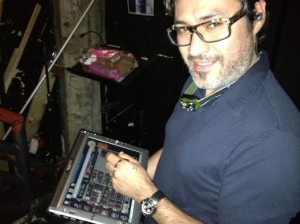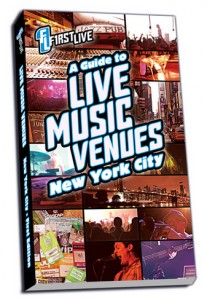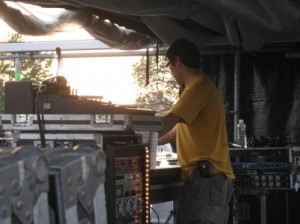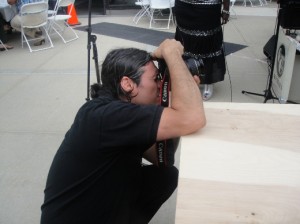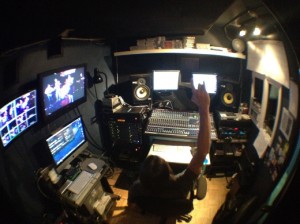Live Sound Outlook, 2013: What the Audio Pros Can Expect
LOWER EAST SIDE, MANHATTAN: Long before, long after — and often on the very same day — artists who hit the studio are hitting the stage.
For a look at the nature of the live sound beast, circa 2013, there’s no better person to check in with than Danny Garcia. A highly experienced soundman who made his way up to New York City from Texas, Garcia is the author of the FirstLive Guide to Live Music Venues. Currently offering NYC and Austin editions, Garcia created FirstLive to put the magic of hundreds of live music stages within easy reach – from Brooklyn Bowl and Arlene’s Grocery to Carnegie Hall and Radio City.
With his viewpoint that takes in live sound from every level, we quizzed Garcia — on the changing outlook for live sound professionals, the artists they mic up, the crowds they entertain, and the venues that gather them all together.
Why did you write the FirstLive Guide? How has that experience changed the way you look at live music?
I have been obsessed with the art of capturing the essence of a live performance ever since visiting a tiny venue in the West Village called Zinc Bar in 1998. The idea to write FirstLive NYC, Guide to Live Music Venues resulted from the need for up-to-date and in-depth information on music venues. Initially, I sought to produce a (Best of) Jazz/World Music CD recorded live at venues in NYC but was sidetracked when looking for information on music venues in New York City.
Live music became a way of life for me in 1993 when I opened a live music venue in El Paso, TX called The Attic. We booked hundreds of national bands (The Deftones, Everclear, Napalm Death, Cannibal Corpse, NOFX, Jimmy Eat World, Black Uhuru) and helped develop the local original music scene (At The Drive-In, Pissing Razors).
For nearly 20 years, my relationship to live music has been that of a live music venue owner, musician, live sound engineer, booking agent, tour manager, consultant for the Gibson Entertainment Relations Showroom NYC, and more recently managing the NY Metro Sales territory for TC Electronic and Blue Microphones.
The experience of publishing FirstLive Guide hasn’t changed how I look at live music, but it has provided me with insight and direction. I am more determined than ever to make FirstLive Guidethe go-to resource for fans and bands, but documenting venues for posterity is of equal importance. My biggest surprise was the difficulty in getting retailers to carry the guide! The shops that do carry it were thrilled with it; they provided music lovers with a one-of-a-kind live music resource.
I’m hopeful that with FirstLive NYC Version 2, the added sections on recording studios, musicians’ foodie guide, and best coffee shops will add value to the core of the guide.
Regardless of how Version 2 is received, the experience of meeting new people, discovering new venues, visiting recording studios, and connecting with artists and sharing their favorite places to eat or have a coffee is for me, living the dream.
How has the job description of the live sound engineer evolved over the last few years – as 2013 kicks off, how is your role the same and in what ways has it changed?
I read somewhere that the job of a live sound engineer is 20% skill and 80% communication. In the past, I would tend to agree but in this day and digital age, I’d have to disagree.
An engineer’s skill level is as equally important as communication especially when navigating around a digital console. Digital consoles are being developed at a rapid rate for both entry-level and high-end users. While on the road as a monitor engineer last year, I mixed monitors at the Triple Door in Seattle with a tablet PC that was connected to a Yamaha PM1D. The tablet froze towards the end of the set but it got the job done. At City Winery in NYC, monitor engineers have the option of mixing from an iPad connected to a Yamaha M7CL. Mixing monitors from a tablet or iPad isn’t ideal, but it’s an indication of where the technology is headed.
Overall, in the context of sound for live music, my job as a sound engineer will never change – use the tools on-hand to deliver great audio! If mixing FOH, make it great for the audience; if mixing monitors, make it great for the musicians on stage; if recording a live event for content creation, provide the client with an exceptional representation of the performance.
In 2013, the plan is to combine live sound production capabilities and publication initiatives into one company – FirstLive Studio. Over the years, my capabilities as a sound engineer have evolved to fulfilling live event production needs. Today, when I think of live sound, I think of sound reinforcement and power requirements, acoustics and environment, instrumentation and backline, staging and stage monitoring, venue capacity, sound check and run-of-show, and live audio and video recording.
How do you think live sound venues changing in NYC? What are the opportunities for them right now?
In compiling venue information for FirstLive NYC and FirstLive Austin, I have found that live sound in smaller venues is relatively unchanged. Most venues get by with minimal sound reinforcement and still employ relatively inexpensive analog boards.
There are a handful of small capacity and mid-sized rooms with state-of-the-art sound reinforcement and high-end digital mixing consoles. The transition from analog to digital is mostly seen in mid-sized to larger venues; also rental companies, and post-production houses.
Live sound is only a part of the live music experience. The longevity of an establishment is reflected by venues that focus on the overall live music experience such as sound, lighting, and acoustics. Bands will first want to play in venues where they have the best time on stage and where their fans will have the best sonic experience. For many venues, the biggest opportunity in regards to sound is improving the acoustics of the room and stage.
On the other hand, what are the biggest threats that live sound venues face in 2013?
The biggest hurdles for a venue other than financial stability is to overcome bureaucratic obstacles, meet sound ordinances, code compliance, and receive the approval of the community board.
Once the doors are open. Repeat the above, again, and again.
Before you know it 10 years has gone by and your lease is up for renewal. During that time, the neighborhood has flourished and the landlord threatens to double the lease. Shameful, but for some, true.
That’s exactly what just happened with the respected venue, The Living Room. So how does the above affect opportunities, job security, and happiness for live sound engineers?
Survival is toughest for venues that rely solely on revenue from bar and tickets sales.
There are many venues that utilize their space in other ways that complement the music. While producing FirstLive Guide, I discovered that some of the best live music venues in New York and Austin serve food. While in Austin, two of my favorite venues to visit for live music and BBQ are Stubb’s and Lamberts.
Staying busy and finding consistent work as a live sound engineer is an ongoing process even for seasoned engineers. Some of the engineers I know are competent in areas other than live sound such as: studio mixing and mastering, corporate events, houses of worship, touring professionals, backline or guitar techs, rental and sound companies, and/or audio for film and commercials.
In your opinion, how are the tools for live sound engineers changing? What are the most significant innovations you can point to that are improving how you do your job?
The best audio purchases I made last year were the PreSonus StudioLive 16.0.2 and the 24-channel version StudioLive 24.4.2. What sealed the deal was price, seamless iPad integration, multitrack recording capabilities; plus onboard processing eliminated the need for carrying additional outboard.
Another board I’m curious about is the newly released Behringer X32 Digital Mixing Console. Controlling a mixer from an iPad is especially useful when ringing out monitors or when the FOH mix position is tucked away in the corner of the room or behind the stage. Loudspeaker active line-array technology is another interest. Speakers are smaller, lighter, powerful and can be tuned to accommodate the room.
Getting a handle on video seems to also be a growing part of the sound engineer’s job description…
My first live audio recording for live video assignment was to multitrack audio record live performances for Digital Club Network (DCN). DCN was one of the first companies to attempt live video streaming of performances at venues in music cities across the U.S.
At the time broadband was very expensive, incredibly slow, and unreliable; standard definition was the norm, and quality issues were a constant challenge. Today, anyone with a microphone, a camera, and some creativity can produce engaging content for their audience. With the advent of affordable DSLR cameras, and HD Video camera’s audio for video is more important than ever — but most videographers come to find that built-in camera microphones or even a decent shock mounted stereo microphone is insufficient and results in poor audio quality.
There is no point in shooting video without a plan for audio. This presents an opportunity for audio engineers to connect with videographers. At the moment, professional field mixers with recording capabilities and timecode are pricey but worth the investment. There is a need for detailed oriented live sound engineers to provide high quality audio for video.
Video plays in to some of the initiatives you’ve undertaken at Arlene’s Grocery with the FirstLive Studio. How is all that shaping your plans for the FirstLive Café?
FirstLive provides in-house recording services at the world famous Lower East Side venue, Arlene’s Grocery. The studio has been a work-in-progress for years.
I’m thrilled with the recent HD video upgrade made possible by the ATEM Television Studio production switcher from BlackMagic Design. It’s an affordable solution to HD video switching and H.264 encoding. Connected to it are four Canon Vixia HF M40
cameras. For audio, we’ve used various mixers along with TC Electronic outboard processing: Ramsa WR-DA7, Allen & Heath, Midas and currently a PreSonus StudioLive 24.4.2.
The audio mix for video is crafted from scratch – all inputs are split on stage. The end product is awesome: A studio engineer is able to provide a band with a 4-camera HD video recording, a professionally mixed 2-track audio CD or a multi-track audio recording available immediately after their show! This month, we’ll be setting up an additional Mac Mini Quad i7 to handle streaming.
The idea behind the FirstLive Studio & Café is simple. Live recording 24/7 in a relaxed creative environment where anyone can enjoy a beverage, simple treats, and WIFI. I believe that opening a FirstLive storefront in cities where guidebooks are published will also help bring exposure to FirstLive Guide initiatives. FirstLive is all about the music – the people who create it and venues where live music happens.
In your opinion, what are the best aspects of being a live sound engineer? And what makes your job a challenge?
This is unique to the individual — for me, the best aspect of working on anything technical in nature is the opportunity to work towards perfection.
Mastering the craft of live sound requires practice. Inevitably, a technical issue will occur during production setup, minutes before show time, or during a show or event. Being prepared for the potential mishap or technical glitch will make you a hero in the eyes of the artist or client.
The ability of a live sound engineer to exist in the “background” and solve problems is invaluable. Solving potential problems is a constant challenge. Minimizing the potential for problems and being prepared for the unexpected is what I like best about being a live sound engineer.
It really sounds as if it brings an immediacy to the rewards of audio engineering. Last question: If a young audio engineer told you they were considering including live sound into their offerings, what would you want to let them know?
You’ve heard it a million times, “If you can make it in New York, you can make it anywhere.”
The pure truth of it is, you can make it in New York as a live sound engineer or as anything you want but it requires an incredible amount of the following: heart, dedication, determination, persistence, humility, confidence, passion, a positive attitude, and the unrelenting will to succeed.
Another consideration is the 10 year or “10,000 hour” rule. Overnight success is unrealistic. From personal experience, it’s only taken me 20 years to survive as a techie. Along the way, I’ve balanced live sound opportunities with nonrelated sound gigs such as a bar back, admin, graphics guy, and more.
Final words, “Go for it – with integrity for yourself and others, and with the spirit of what live sound means to you.”
— David Weiss
Please note: When you buy products through links on this page, we may earn an affiliate commission.







